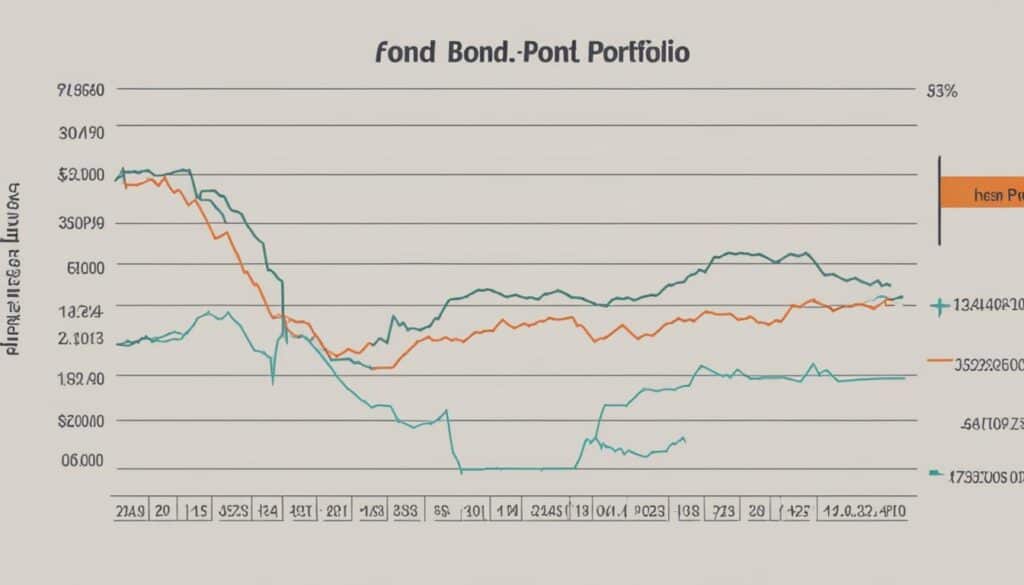Retirement planning is a crucial step in securing one’s financial future. As I plan for my own retirement, I understand the importance of making smart investment decisions that provide stability and reliable income. One investment option that stands out is bonds.
Bonds are debt securities issued by corporations, municipalities, and governments to raise capital. They offer fixed interest payments over a specified period, making them attractive to retirees looking for a steady income source. With their lower volatility compared to stocks, bonds can provide stability to a retirement portfolio, ensuring a financially secure future.
Key Takeaways:
- Bonds can play a significant role in retirement planning by providing stability and reliable income.
- They are debt securities issued by corporations, municipalities, and governments.
- Bonds offer fixed interest payments over a specified period.
- They have lower volatility compared to stocks, making them appealing for retirees.
- Incorporating bonds into a retirement portfolio can help secure a more financially stable future.
Types of Bonds for Retirement
When it comes to retirement planning, there are several types of bonds that retirees can consider. Each type offers different features and benefits, allowing individuals to tailor their investment strategy to match their financial goals and risk tolerance. In this section, we’ll explore three common types of bonds: Treasury bonds, corporate bonds, and municipal bonds.
Treasury Bonds
Treasury bonds are issued by the U.S. government and are often regarded as the safest investment option for retirees. These bonds come with low default risk, as they are backed by the full faith and credit of the U.S. government. Treasury bonds offer fixed interest payments, known as coupon payments, which are paid semi-annually. Their maturities range from 10 to 30 years, providing retirees with long-term investment options. While treasury bonds offer lower interest rates compared to other types of bonds, they provide stability and are considered a cornerstone of a conservative retirement portfolio.
Corporate Bonds
Corporate bonds are issued by companies to raise capital for various purposes, such as financing corporate expansions or funding new projects. These bonds offer higher interest rates compared to treasury bonds, reflecting the additional risk associated with corporate debt. With corporate bonds, investors lend money to companies in exchange for regular interest payments and the return of the principal investment upon maturity. The risk level of corporate bonds can vary depending on the creditworthiness of the issuing company, as indicated by credit ratings provided by credit rating agencies. Retirees seeking higher yields may consider corporate bonds but should carefully assess the credit quality of the issuer to mitigate potential default risk.
Municipal Bonds
Municipal bonds are debt securities issued by local governments, such as cities or states. These bonds are often attractive to retirees in higher tax brackets because the interest income generated from municipal bonds is typically exempt from federal income taxes. In some cases, municipal bonds may also be exempt from state and local taxes, providing additional tax advantages. Municipal bonds can be further categorized into general obligation bonds, which are backed by the full faith and credit of the issuing municipality, and revenue bonds, which are backed by the revenue generated from a specific project, such as a toll road or a municipal utility. Retirees interested in tax-efficient income may find municipal bonds a valuable addition to their retirement portfolio.
By diversifying bond investments across various types of bonds, retirees can effectively manage risks and maximize returns. Treasury bonds offer stability, corporate bonds provide higher yields with increased risk, and municipal bonds offer tax advantages. The specific mix of these bonds within a retirement portfolio should be based on an individual’s risk tolerance, financial goals, and income needs.
Benefits of Bonds in Retirement Planning
Bonds offer numerous benefits that make them a valuable asset in retirement planning. Let’s explore some of the key advantages they provide:
Steady Income Stream for Retirement
One of the primary benefits of bonds is their ability to generate a steady income stream. When retirees invest in bonds, they receive regular interest payments, which can serve as a reliable source of income to cover their living expenses during retirement. This consistent cash flow provides financial stability and peace of mind.
Capital Preservation and Stability
Bonds are known for their capital preservation characteristics. Unlike stocks, which can be subject to significant market fluctuations, bond values tend to be more stable over time. This stability helps retirees protect their capital and maintain the value of their investments, ensuring a more secure financial future.
Diversification and Risk Management
Another advantage of including bonds in a retirement portfolio is diversification. By holding a mix of different types of bonds, retirees can spread their risk across various asset classes. This diversification helps offset potential losses that may occur in other investment vehicles, such as stocks or real estate. It promotes a balanced portfolio that can withstand market volatility and reduce overall risk exposure.
“Diversification is an essential aspect of retirement planning. Including bonds in your investment strategy can contribute to effective risk management and enhance the overall performance of your portfolio.”
– John Smith, Financial Advisor
Summary Table: Benefits of Bonds in Retirement Planning
| Benefits | Description |
|---|---|
| Steady Income Stream | Regular interest payments provide a reliable source of income during retirement. |
| Capital Preservation | Bond values have more stability and are less susceptible to market fluctuations, preserving capital. |
| Diversification | Including bonds in a diverse portfolio helps manage risk by offsetting potential losses. |
With its potential for generating a steady income stream, capital preservation features, diversification benefits, and risk management capabilities, including bonds in retirement planning can significantly contribute to a secure and well-structured financial future.
Considerations for Bond Investing in Retirement
Retirees should consider several factors when investing in bonds for retirement. The decision to invest in bonds relies on a careful assessment of various considerations such as interest rates, credit ratings, maturity dates, and inflation protection.
Interest rates play a significant role in bond prices, making them a crucial factor to consider. It is important to pay attention to the prevailing interest rate environment as higher interest rates can lead to lower bond prices, and vice versa. Retirees should stay informed about the current interest rate trends to make informed investment decisions.
Credit ratings are another critical factor in bond investing. They indicate the issuer’s ability to meet its debt obligations and can help retirees assess the default risk associated with different bonds. Investing in bonds with higher credit ratings can provide lower default risk and greater peace of mind.
Maturity dates also play a crucial role in bond investing. Retirees should carefully align the maturity dates of bonds with their retirement goals. If there are specific financial milestones or expenses that need to be met during retirement, selecting bonds with appropriate maturity dates can help ensure the availability of funds when needed.
Inflation protection is an important consideration for retirees looking to preserve their purchasing power over time. Inflation-linked bonds can provide protection against inflation by adjusting their value in line with changes in the inflation rate. This can help retirees maintain the real value of their investments and protect against erosion due to rising prices.
Retirees should consider interest rates, credit ratings, maturity dates, and inflation protection when investing in bonds for retirement.
Considering all these factors in bond investing can help retirees make informed decisions and build a bond portfolio that aligns with their retirement goals and risk tolerance.
Building a Bond Portfolio for Retirement
When it comes to planning for retirement, building a well-balanced bond portfolio is a crucial step. This involves careful asset allocation and diversification to ensure stability and maximize returns. Two popular strategies for constructing a bond portfolio are the bond ladder and investing in bond funds.
Bond Ladder Strategy
The bond ladder strategy involves purchasing bonds with different maturity dates. By spreading out your investments across a range of maturity dates, you can create a consistent income stream and maintain flexibility for reinvestment. When a bond matures, the proceeds can be reinvested in a new bond at the longest end of your ladder, ensuring a continuous income stream.
For example, let’s say you have a bond ladder consisting of bonds with maturities of 1, 3, 5, 7, and 10 years. As each bond matures, you can reinvest the proceeds into a new 10-year bond. This approach provides stability and the opportunity to capture higher interest rates as you periodically reinvest in new bonds.
Investing in Bond Funds
Another option for building a bond portfolio is to invest in bond funds. Bond funds pool money from multiple investors and are managed by professionals who allocate the investments across a diversified portfolio of bonds. This offers instant diversification without the need for individual bond selection and management.
Bond funds come in various types to cater to different risk profiles and investment goals. For retirees, bond funds that focus on income generation and capital preservation are often recommended. These funds provide a steady income stream while minimizing the risk of capital loss.
Investing in bond funds can be a convenient and effective way to gain exposure to a diversified bond portfolio. However, it is important to carefully assess the fund’s investment strategy, management fees, track record, and risk profile before making any investment decisions.
Seeking Professional Advice
Constructing a bond portfolio for retirement requires careful consideration of individual risk tolerance, income needs, and retirement goals. It is recommended to seek professional advice from a financial advisor or investment consultant who can provide personalized guidance.
A professional can help assess your financial situation, recommend suitable asset allocation strategies, and select bonds or bond funds that align with your investment objectives. They can also monitor and rebalance your portfolio as needed to ensure it remains on track.
Remember, every individual’s financial situation is unique, and professional advice can provide valuable insights and expertise tailored to your specific needs.
Conclusion
In conclusion, incorporating bonds into your retirement planning can be a wise decision to secure a more stable and financially secure future.
By considering various types of bonds and their benefits, you can make informed decisions that align with your individual needs and goals.
Building a well-balanced bond portfolio requires careful consideration of factors such as interest rates, credit ratings, and maturity dates.
With proper planning and professional guidance, bond investments can become an essential component of a comprehensive retirement plan, providing stability, consistent income, and diversification for a secure financial future.
FAQ
What is the role of bonds in retirement planning?
Bonds play a crucial role in retirement planning by providing stability and reliable income. They are lower-risk investments that offer fixed interest payments over a specified period, making them attractive to retirees.
What are the types of bonds retirees can consider for their retirement planning?
Retirees can consider treasury bonds, corporate bonds, and municipal bonds. Treasury bonds are issued by the U.S. government and are considered the safest investment. Corporate bonds are issued by companies and offer higher interest rates but carry more risk. Municipal bonds are issued by local governments and are often tax-exempt.
What benefits do bonds offer in retirement planning?
Bonds provide a steady income stream through regular interest payments and are known for capital preservation. They also offer diversification, helping retirees manage risk by offsetting potential losses in other asset classes.
What factors should retirees consider when investing in bonds for retirement?
Retirees should consider prevailing interest rates, credit ratings, and maturity dates of bonds. Higher interest rates can lead to lower bond prices, while credit ratings indicate the issuer’s ability to meet debt obligations. Maturity dates should align with retirement goals.
How can retirees build a bond portfolio for retirement?
Retirees can employ a bond ladder strategy, where bonds with different maturity dates are purchased for a consistent income stream and flexibility for reinvestment. Alternatively, they can invest in bond funds, which offer instant diversification and are managed by professionals.
Why are bonds an essential component of a comprehensive retirement plan?
Bonds offer stability, income, and diversification, which are crucial for securing a stable and financially secure future. By incorporating bonds into their retirement strategy, individuals can enhance their retirement planning and secure their financial future.
Source Links
- https://www.hl.co.uk/news/articles/cybersecurity-why-it-matters-and-2-share-ideas
- https://sports.yahoo.com/rolltidewire-writers-predict-alabama-football-171919561.html
- https://www.morningstar.com/news/dow-jones/202401115734/ice-canola-holding-onto-small-gains
Disclaimer
All information on this website is of a general nature. The information is not adapted to conditions that are specific to your person or entity. The information provided can not be considered as personal, professional or legal advice or investment advice to the user.
This website and all information is intended for educational purposes only and does not give financial advice. Signal Mastermind Signals is not a service to provide legal and financial advice; any information provided here is only the personal opinion of the author (not advice or financial advice in any sense, and in the sense of any act, ordinance or law of any country) and must not be used for financial activities. Signal Mastermind Signals does not offer, operate or provide financial, brokerage, commercial or investment services and is not a financial advisor. Rather, Signal Mastermind Signals is an educational site and a platform for exchanging Forex information. Whenever information is disclosed, whether express or implied, about profit or revenue, it is not a guarantee. No method or trading system ensures that it will generate a profit, so always remember that trade can lead to a loss. Trading responsibility, whether resulting in profits or losses, is yours and you must agree not to hold Signal Mastermind Signals or other information providers that are responsible in any way whatsoever. The use of the system means that the user accepts Disclaimer and Terms of Use.
Signal Mastermind Signals is not represented as a registered investment consultant or brokerage dealer nor offers to buy or sell any of the financial instruments mentioned in the service offered.
While Signal Mastermind Signals believes that the content provided is accurate, there are no explicit or implied warranties of accuracy. The information provided is believed to be reliable; Signal Mastermind Signals does not guarantee the accuracy or completeness of the information provided. Third parties refer to Signal Mastermind Signals to provide technology and information if a third party fails, and then there is a risk that the information may be delayed or not delivered at all.
All information and comments contained on this website, including but not limited to, opinions, analyzes, news, prices, research, and general, do not constitute investment advice or an invitation to buy or sell any type of instrument. Signal Mastermind Signals assumes no responsibility for any loss or damage that may result, directly or indirectly, from the use or dependence on such information.
All information contained on this web site is a personal opinion or belief of the author. None of these data is a recommendation or financial advice in any sense, also within the meaning of any commercial act or law. Writers, publishers and affiliates of Signal Mastermind Signals are not responsible for your trading in any way.
The information and opinions contained in the site are provided for information only and for educational reasons, should never be considered as direct or indirect advice to open a trading account and / or invest money in Forex trading with any Forex company . Signal Mastermind Signals assumes no responsibility for any decisions taken by the user to create a merchant account with any of the brokers listed on this website. Anyone who decides to set up a trading account or use the services, free of charge or paid, to any of the Broker companies mentioned on this website, bears full responsibility for their actions.
Any institution that offers a service and is listed on this website, including forex brokers, financial companies and other institutions, is present only for informational purposes. All ratings, ratings, banners, reviews, or other information found for any of the above-mentioned institutions are provided in a strictly objective manner and according to the best possible reflection of the materials on the official website of the company.
Forex/CFD trading is potentially high risk and may not be suitable for all investors. The high level of leverage can work both for and against traders. Before each Forex/CFD investment, you should carefully consider your goals, past experience and risk level. The opinions and data contained on this site should not be considered as suggestions or advice for the sale or purchase of currency or other instruments. Past results do not show or guarantee future results.
Neither Signal Mastermind Signals nor its affiliates ensure the accuracy of the content provided on this Site. You explicitly agree that viewing, visiting or using this website is at your own risk.




